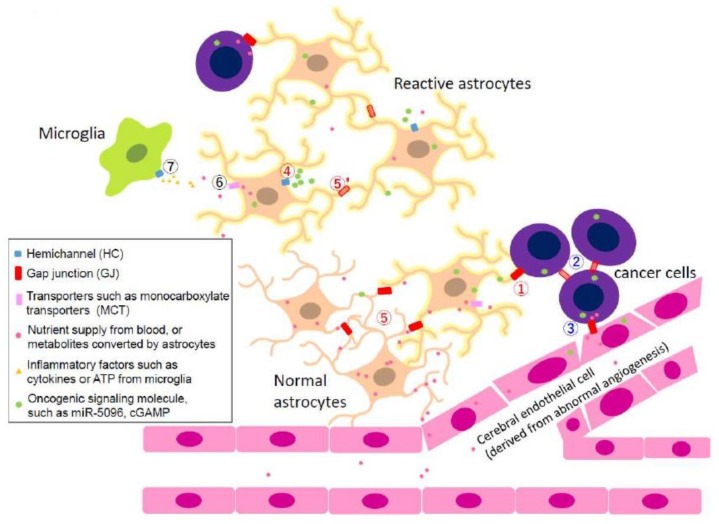Figure 1.
The microenvironment of glioma or metastatic cancers in central nerve system (CNS). Reactive astrocytes have increased Cx43 and GFAP levels, while PTEN, a well-known tumor suppressive protein, is decreased. Cerebral endothelial cells (CECs) also participated here as angiogenesis inducing factor and supply nutrients. Microglia increases glucose uptake by astrocytes. Numbers in circle indicate GJ or HC pathways to maintain this environment. Red colored pathways (1, 4, 5 and 5′) are common between glioma and metastatic cancers. Blue colored pathways (2 and 3) are derived from previous reports on glioma (84,101). Black colored pathways (6 and 7) denotes those around reactive astrocyte in inflammatory condition [3]. Pathway 1: GJ between a cancer cell and an astrocyte; it promotes tumor invasion by transferring oncogenic signaling molecules from a cancer cell to an adjacent astrocyte. Pathway 2: GJ between glioma cells; down-regulation of GJ promotes invasion of glioma. Pathway 3: GJ between glioma and CEC; it promotes angiogenesis. Pathway 4: HC activity of reactive astrocyte; it contributes to spreading of oncogenic signaling molecule in the brain. Pathway 5: GJ between normal astrocytes; it supports nutrients supply from CECs to CNS cells. Pathway 5′: GJ between astrocytes located distal from the tumor; it is mainly down-regulated when HC is upregulated. Pathway 6: Transporters expressed in astrocytes located distal from the tumor; they are believed to be upregulated to uptake enough metabolites. Pathway 7: HC activity in microglia; it may support increase of glucose uptake in astrocytes, while it decreases spread of glucose between astrocytes.

